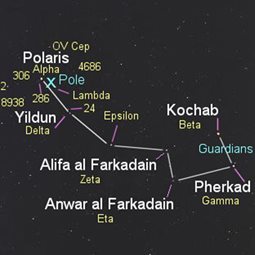Playing is Learning
Star Names of Ursa Minor
June 17th, 2015
| Ads | ||
|
Play the Challenge
|
||
|
A New Word is Coined A new Character is revealed A new Game is Afoot |
An Edutainment Adventure Based on Three Rounds of Investigations
|
|
|
Welcome to the World of PROFESsee™by seeCOSM™ PROFESsee™ is my title. I am the perpetual learner, in pursuit of knowledge, wisdom and truth. I derived my name from professor |
 |
|
|
Apart from the five major stars that are located in the Ursa Minor, there are several other stars, and many other bodies of organs and particles that are also located therein. The stars, apart from their astronomical meanings and functions, have much other significance. These are mostly mythological, but in some cases also historical. The Polaris, which is obviously the number one and most popular of these, is more important than others when it comes to polar travels. It has garnered a lot of names according to people’s conception of its importance. These names include Stella Maris, which means the star of the sea. Others also see it as Alruccabah, Phoenice and Lodestar meaning the guiding star. It is also called the Cynosura, which means the dog's tail as derived from the Greek language. Many other people regard this as Yilduz or Mismar which means needle or even nail. Others call it star of Arcady, Angel Stern, Navigatoria, Tramontana and pole star. The Kochab, which is also known as the beta Usae Minoris and the pherkad, is called the gamma Usae minoris as well goes with the name the guardians of the pole. This is a name necessitated by the fact that they are seen to be rotating around the Polaris star. They are the two stars that are closer to the North Pole within 15000 BC and 500 AD. The Kochab has its name derived from an Arabic word al-kawkab, taken from al-kawkab al-šamaliyy, which means the North Star. The Yildun is the star that is about 183 light-years from the earth, with a visual magnitude that is put at about 4.35. The name yildun is derived from a Turkish word yildiz, which means star. In some cases, it is also called Gildun, Yilduz, Vildiur and Jildun, all meaning star. Akhfa al Farkadain, which is also called the Zeta Ursae Minoris, is the star that is about becoming a giant star. Its mass is estimated to be 3.4 times that of the sun. It also gives the light of the sun 200 times. Some refer to it as a Delta Scuti variable. The name is derived from a?fa al-farqadayn, meaning “the dimmer of the two calves.” It has about 380 light years distance from the earth. There is also the Anwar al Farkadain, which is moreover derived from Anwar al-farqadayn, meaning “the brighter of the two calves.” Can you Zoom to the correct stars? Image courtesy of: http://www.ahgonline.org/pages/page.asp?page_id=21736 |
||
Latest News / Events
E-mail [email protected]
The Professee™ Newsletter Beta
http://www.seecosm.com/
http://www.seecosm.com/

